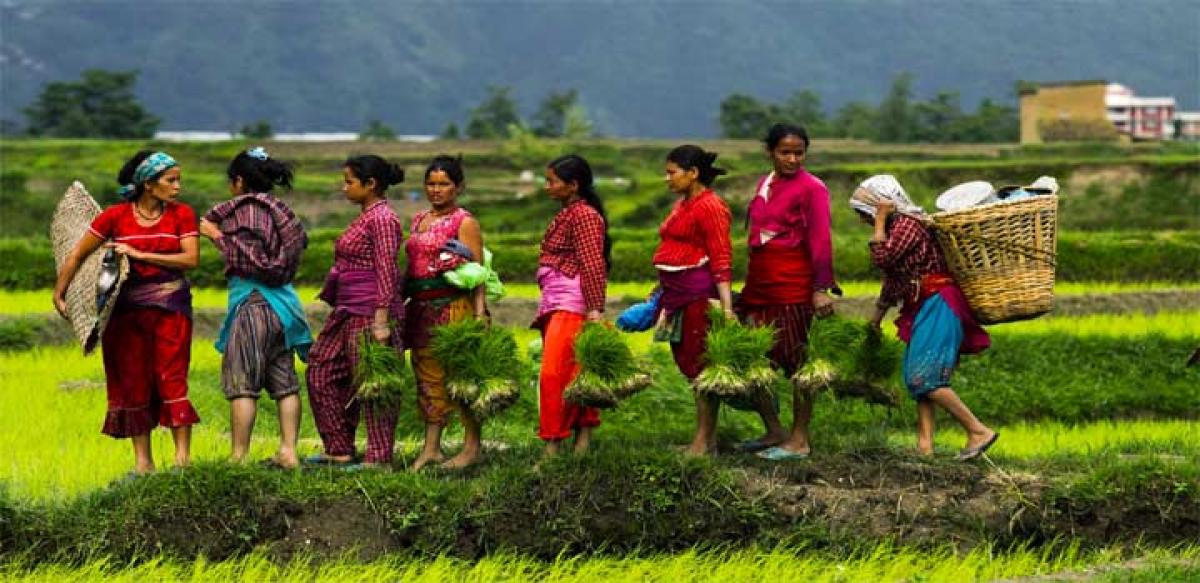Live
- Unveiling the Hidden Gems: Surprising Health Benefits of Garlic Peels
- Overcoming Sleep Struggles: A Comprehensive Guide to a Restful Night
- RTC bus hit the auto
- MLA Kuchukula Rajesh Reddy participated in the Birappa festival
- DMHO starts awareness campaign on Malaria
- World Intellectual Property Day 2024: Date, History, Significance, and Everything You Need to Know
- Shiv Sena-UBT manifesto assures dignity to all states; ‘no’ to polluting nuclear, refinery mega projects
- IPL 2024: Delhi Capitals sign Gulbadin Naib to replace injured Mitchell Marsh
- Delhi court grants 30-day extension to police to conclude probe in Parliament security breach case
- Cash, liquor, drugs valued at Rs 321 crore confiscated in Punjab
Just In

Nepal farmers defy climate challenges. Farming in Nepal has run into rough weather -- literally. Farmers in Kavrepalanchok district, 45 km northeast of the national capital, are facing difficulties owing to scarce rains and rising temperature and the extent to which climate change is affecting their livelihoods.
Farming in Nepal has run into rough weather -- literally. Farmers in Kavrepalanchok district, 45 km northeast of the national capital, are facing difficulties owing to scarce rains and rising temperature and the extent to which climate change is affecting their livelihoods.
.jpg)
"There is a noticeable change in climate. Now the onset of summer is too early and that often results in either premature ripening of crops or their not gaining optimum size," vegetable grower Babu Ram Dhithal, who lives in Patlekhet village, told this correspondent. He said the normal rainfall patterns have changed a lot.
"When our crops need rainfall, there are often long dry spells. And when it rains, it's plentiful and most of the time it's a flood-like situation that damages the crops more," the 42-year-old farmer explained. Nepal's economy largely depends on agriculture, which is mainly rain-fed. Sixty-five percent of the people are engaged in agriculture.
The World Bank says agriculture accounts for more than 30 percent of the country's gross domestic product. According to the World Bank, 47 percent of Nepalese farmers have less than half-a-hectare of land. But there is a silver lining in these black clouds for the farmers in the form of a programme that aims to create "Climate Smart Villages".
The ICIMOD (International Centre for Integrated MountainDevelopment), headquartered here, is implementing the Climate Smart Village programme in five villages in Kavrepalanchok district under the Himalayan Climate Change Adaption Programme (HICAP).
The programme aims to adopt water-smart, cropping-smart, energy-smart and IT-smart practices. Agriculture expert Keshab Dutt Joshi said the planting schedule has been changed in the low hills of Nepal because of change in rainfall patterns and temperature increases.
"A decade back there would be two summer rice crops followed by one winter crop," Joshi, who is associated with NGO Center for Environmental and Agricultural Policy Research, Extension and Development (CEAPRED), said. "Now the farmers are cultivating wheat, followed by rice in summer and then one crop in winter.
They opted for the wheat crop because of less rainfall. This clearly indicates the change in climatic conditions," he added. Abid Hussain, ICIMOD's food security economist, said a pilot field survey was conducted in the five adopted climate smart villages to study the existing water management practices, cropping patterns, energy sources and nutrients and soil management.
To cope with declining agriculture production and increased outbreaks of insects and disease, Hussain said water-smart, cropping-smart, energy-smart and IT-smart practices have been adopted. According to Hussain, this method requires less water and fewer seedlings compared to the traditional rice cultivation.
Rice grower Nani Maiya Dhungana of Kalchebesi village said for the first time they have adopted the SRI method of cultivation. As an example, she said instead of pesticides, the farmers in the village are using home-brewed alternatives.
By VISHAL GULATI

© 2024 Hyderabad Media House Limited/The Hans India. All rights reserved. Powered by hocalwire.com







